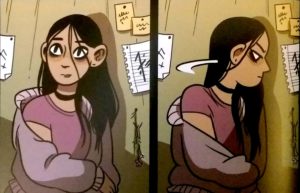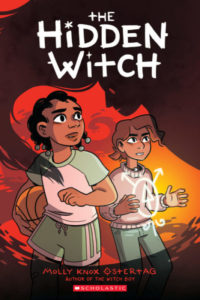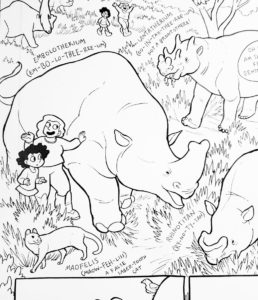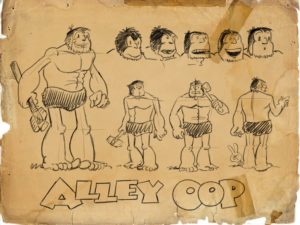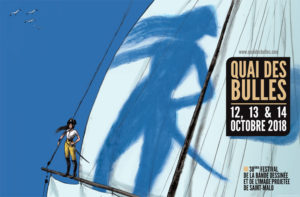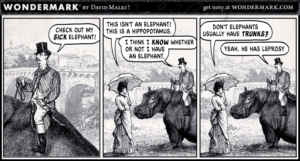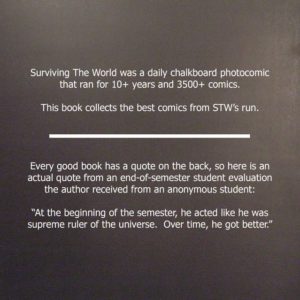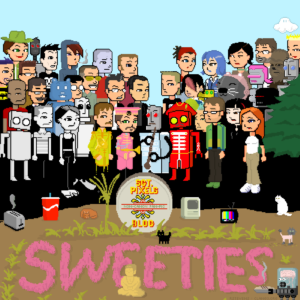Fleen Book Corner: The Hidden Witch
Do I need to say it? There’s spoilers ahead.
The Hidden Witch by Molly Ostertag released last Tuesday, and I’ve been reading it (in whole, front to back, back to front, certain sections again and again) nearly nonstop since then. I must confess that I feared I wouldn’t love it as much as I built it up in my mind. After all, I loved the first book in the series, The Witch Boy (just yesterday, I was earnestly recommending it to the youth librarian in my town’s public library), and it was possible that it wouldn’t live up to my expectation.
I should have trusted Molly.
Which, in a way, is the lesson of The Hidden Witch. Trust is a tough thing to give, a tough thing to receive, and if we are brave enough to trust, and lot of grief can be avoided. If we can trust those who are different than us, can trust ourselves to see the good in them, we can maybe heal the hurts of the world.
Quick primer for those that skipped The Witch Boy: go read The Witch Boy. Do it now. If you absolutely can’t do it now for a damn good reason — like you’re on a ship at sea, or that one Russian dude that stabbed somebody in your Antarctic research station for being a jerk about spoilers is giving you the hairy eyeball, here’s the deal:
Aster’s just on the edge of his teen years; his family is magic, and the rules are clear: boys are shapeshifters, girls are witches. You can bend or stretch any rule you want except that one, and for damn good reasons — within living memory a boy that was determined to learn witchery was corrupted by dark magic and became a dangerous beast. Aster doesn’t want to become a beast, but he feels he’s a witch. Nobody really understands him but Charlie, the girl from town who’s nonmagical and doesn’t get the rules. Oh, and that beast? It’s picking off Aster’s cousins as they learn shapeshifting.
It’s also Aster’s grandmother’s brother, Mikasi; he had a talent for witchcraft, she has some skill shifting, and he got lost. It’s only because Aster escapes Mikasi’s notice that he’s able to help capture the beast — no boy would be a witch, no shifter could resist Mikasi’s power, and so he doesn’t think to guard against a witch boy. At the end, Mikasi is captured (but not redeemed), the family still loves Aster (well, they haven’t kicked him out or anything), and they’re trying to figure out what to do. It helps that Grandmother puts her foot down — Aster’s a witch.
Fast forward to the current book and Aster’s still finding his way in his family; not all of them are accepting of his choices in life. Mikasi is still captive and bestial, and while Grandmother knows how to take the darkness from him, she needs Aster’s help. That means that more than anything else, Aster must be open to understanding what drove Mikasi to become corrupted. Aster doesn’t want to understand, he’s much more comfortable retreating — and it’s not unreasonable for anybody to say He tried to kill me and corrupt my cousins (even if they’re dicks to me sometimes) and I’m not cool with having to forgive.
But he does. And little by little, Mikasi starts to emerge, a half-century or more older than he remembers being.
Meanwhile, Aster’s cousin Sedge is having misgivings about his role in life; unlike Aster, he went along with the way things are done, but now that he’s seen darkness he’s not sure he wants to shift again. Maybe he never wanted to shift in the first place. But now that Aster’s shown mold-breaking is possible, Sedge is admitting it out loud, and to himself. He doesn’t want to be a witch, though — he wants to be a nonmagical kid, go to middle school, study math and science. It might be an even bigger break with How Things Are Done than Aster’s was.
And then there’s the unknown witch, one who’s messing with dark things not understood, one at risk of falling into the same corruption that took Mikasi. She’s a new kid in Charlie’s class, one that just wants friends but has so convinced herself she doesn’t have any (or deserve any) that she pushes everyone away. And there’s this helpful shadow that she can use to torment those who are mean to her (or pre-emptively before they get the chance to be), and her temper is shorter by the day. Charlie wants to be friends, but untrained witch Ariel doesn’t really know what that means. Her conception of friendship is full of exclusivity — almost possession — and runs riot with a jealous need to protect what she regards as hers.
Charlie isn’t magic except that she’s got empathy, and will risk danger among all these magic-slingers for the sake of a friend, even one that doesn’t think she’s a friend. Aster and Mikasi have the magic to clean up the darkness that tries to claim Ariel, but it’s Charlie that makes it possible. This is the central message of the story — magic is not greater than the bonds we make between ourselves.
Nowhere does Ostertag get at the heart of the contradictions that define us all (but especially teens and tweens) as in two simple panels. Charlie, Aster, and Sedge have made it past Ariel’s creatures and arrive to confront her — not in anger, but out of concern. Ariel is just starting to realize that she can’t control what she has unleashed and when she sees Charlie she’s relieved and grateful, followed quickly by closed off and resentful. She doesn’t like herself, she can’t believe anybody would like her, and so Charlie can’t be here to help her and screw her anyway.
Two panels. A heartbeat’s worth of time in the gutter between them. Two pictures. A lifetime of hurt and mistrust conveyed with utter crystalline clarity by the simple motion of Ariel turning away. And then the exchange that gets to who these characters are in eight words:
Charlie: Ariel —
Ariel: I don’t want you here.
Charlie: Too bad.
Oh, there’s more. Charlie not letting Ariel wall herself off, telling her that she deserves friendship, she’s worthy of it, to not be afraid of accepting it, to not let her darker impulses rule her emotions. There’s other small moments that pack as much in (Aster revealing to Sedge that he’s been helping Mikasi heal, Mikasi admitting the monster still resides in him), and there’s more sacrifice and growth on the part of nearly everybody. But those two panels, those eight words are the high point of the book. They pack all the emotions and lessons learned into their truest form — I’m here for you, and if you try to push me away, I’m still here for you. You’re hurt. You’re family.
There’s a reason that Charlie is the larger (and foregrounded) character on the cover; Aster’s story may be the throughline, Ariel’s may be the central focus, but Charlie’s the hero this time. She doesn’t need to study or dabble in esoteric knowledge — she’s got the simplest of the powers of anybody here. She knows how to offer friendship and to accept it in return. She knows how to call you on your crap when you deserve it, but let you know that she still loves you unconditionally. She knows how to bring out the best in people. She’s willing to help you with your damage. And she’ll literally dunk on you if try to mess with her friends; that basketball ain’t just for show.
The messages of The Witch Boy are still there, still being expanded on, but The Hidden Witch adds a very important truth to the mix — being different doesn’t mean you have to be alone, and those who aren’t perceived as different have the ability to welcome the lonely, the distressed, the outcast. If The Witch Boy taught every kid struggling with feelings they didn’t know how to process about who they are and who they can be, The Hidden Witch reminds every reader that being welcoming and open to who people are is our job. I know in my heart that in the past year, kids that see themselves in Aster are better off for his example; I know that in the year to come, kids that see themselves in Charlie are going to help those Asters and Ariels and Sedges find the space to be themselves.
And that’s magic.
The Hidden Witch, words and pictures by Molly Ostertag, is available at bookstores everywhere. It’s appropriate for every age that has the patience to consume a 200 page story.
Spam of the day:
Your Dishwasher repair costs are covered (complete details inside…)
In fact, my dishwasher had a problem — the gasket that seals the door had gotten folded over, making it impossible to close it fully. I fixed it with the foldy-over sealing cardboard from the top of a FedEx envelope.
